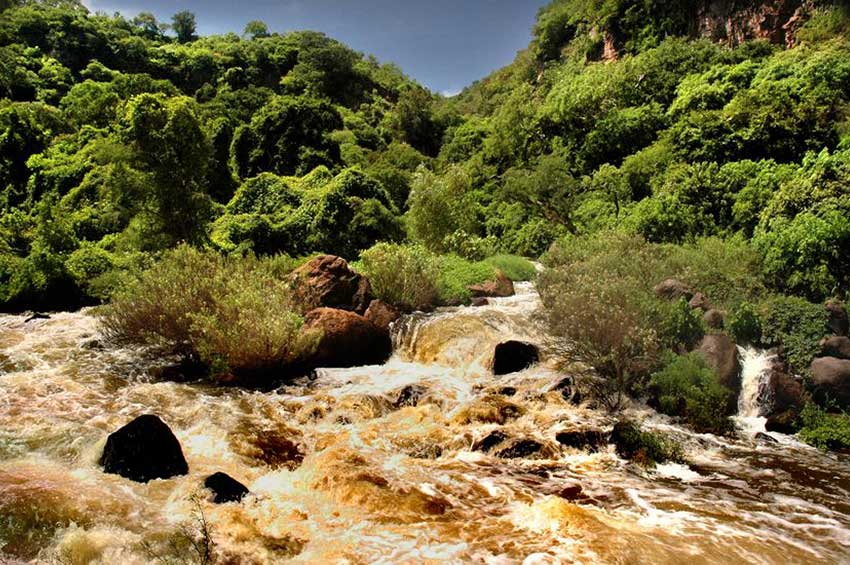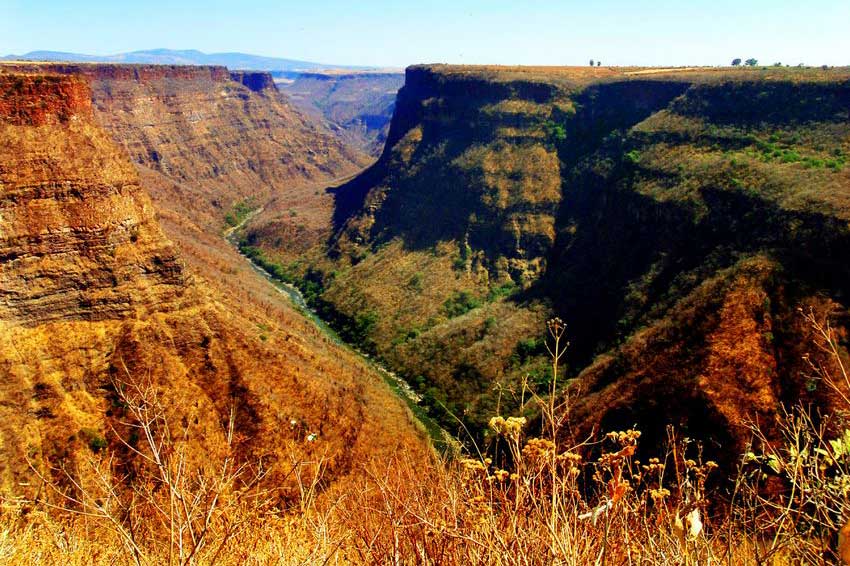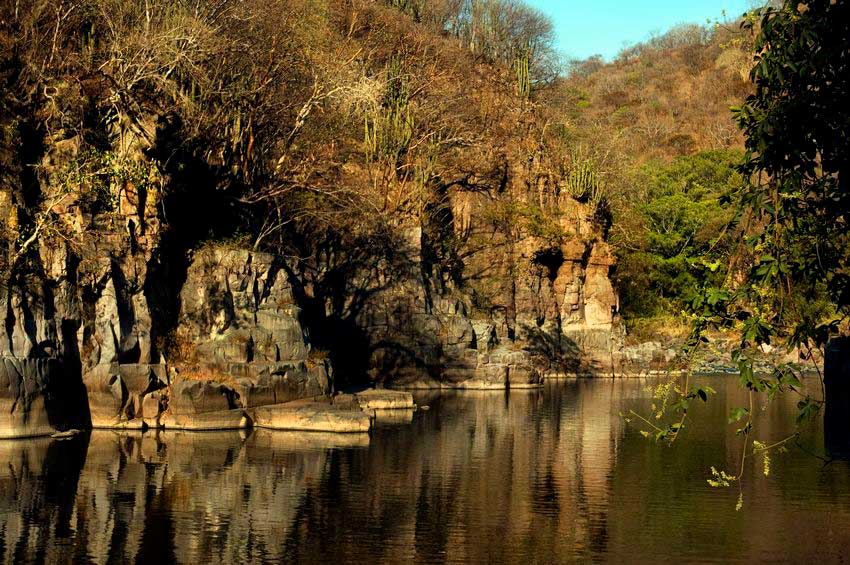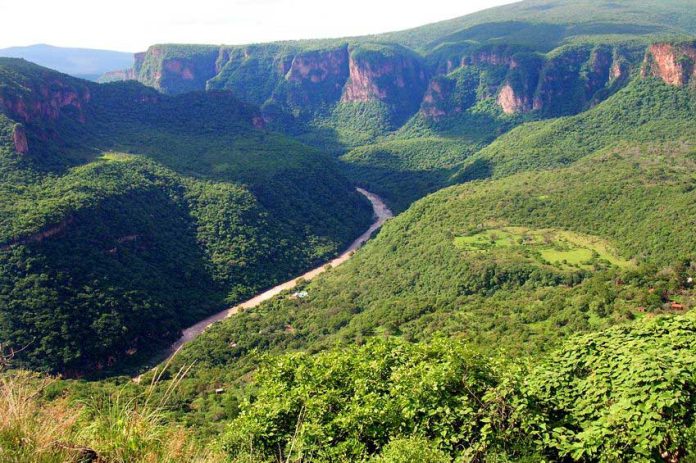The Río Verde could be considered western Mexico’s “forgotten river,” principally because it runs along the bottom of a long canyon 300 to 500 meters deep, accessible only via a few steep, rough, dirt roads.
It is so forgotten that I couldn’t find its length anywhere, so I made my own measurements and, “according to Pint,” it is 173 kilometers long, starting deep in the Jalisco highlands and ending at Guadalajara.
Thanks to its isolation the river is relatively unpolluted, and all along its length are wonderful hot springs. Add these two factors to the astounding beauty of the steep canyon walls overhanging the river and you have a great outdoor site well worth a visit.
My first trip to the Green River was rather bizarre. I received a phone call from botanist Miguel Cházaro asking me if I wouldn’t like to visit “a hot waterfall called La Bolsa. It’s a natural shower, at perfect bathing temperature and it’s located at the edge of a huge orchard where ripe mangoes drop right into your hands and, by the way, just above the orchard there’s an archaeological site with a big pyramid and . . . .”
Of course, I was hooked and so were a lot of other hiker friends when I told them Cházaro’s story. The result was a big turnout for a hike to La Bolsa.

“How far away is this place?” people asked me.
“Miguel says it’s just half an hour from town.”
“What should we bring?”
“I guess lunch and a swim suit is all you need.”
Well, the “half-hour trip” took two hours, which did not surprise me too much, but instead of arriving at the hot waterfall, we found ourselves on the edge of a tremendous canyon, at the bottom of which we could barely make out a narrow ribbon of brown: the Río Verde, normally green, but chocolate-colored during the rainy season.
“Just follow me,” said Miguel, and over the edge we went, slipping and sliding on muddy trails that zigzagged through thick maleza which slowly turned into a full-blown jungle as we descended. All of us figured the waterfall must be “a half-hour” down the hill, but it soon became clear we were heading for the very bottom of the canyon.

One hour later, we came to a wide, flat, open area dominated by a conspicuous, high, lozenge-shaped mound where we learned about the history of the area.
“The Aztecs,” we were told, “arrived at Acatic in the year 1200 and almost decided to make it their capital because they saw an eagle land there. However, the eagle took off again and so did the Aztecs, wandering away to what is now Mexico City, where they finally saw the omen they were seeking: an eagle devouring a snake while perched on a nopal [prickly pear cactus].”
We continued down the hill and finally, four hours after leaving Guadalajara, we reached our long-awaited hot waterfall. Ah, but for most of the group it was quite a disappointment.
“The bathing spot looked great,” stated one exhausted hiker, “but to get to it you had to grab on to the branch of a tree overhanging the roaring, frothing Rio Verde. I was not quite prepared to do that.”
As a result, only three out of the crowd of 20 actually got a chance to stretch out under the marvelous hot waterfall they had striven so hard to reach. I was one of those lucky three and as I lay beneath the falls with jets of deliciously hot water pummeling my back in a soothing massage, I asked myself, “Was it worth it?”
For me, the reply was a resounding “Claro que sí!” but for those others, who now faced the prospect of climbing back up the canyon’s muddy trails in the pouring rain, the answer may have been quite the opposite, especially for one exhausted soul who looked up at the top of the canyon far above us, threw himself down on the ground, arms outstretched, and declared, “I’d rather just die right here, if you don’t mind!”

Fortunately, he and everyone else eventually made it to the top, although a few only reached it at sunset.
Some time later, a local historian told me about another way into the same canyon where I would be able to appreciate “three magnificent waterfalls, one of them 70 meters high.”
This place is known as La Leonera and I assumed it would present a daunting challenge equal to that of La Bolsa, but I was wrong.
We drove to La Leonera from the little down of Acatic and only a few steps from the parking spot parked we stood next to a mirador, or lookout point, offering us a truly magnificent and dramatic view of the Río Verde canyon. From here you walk along a wide, smooth path, again with a stupendous view.
We strolled along for an hour, finally coming to a little stream. Here we could just hear the purr of a waterfall in the distance. We walked upstream for 100 meters and gaped at la Cascada Velo de la Novia (Bridal Veil), a pretty and appropriately named waterfall about 60 meters high.
Below it was a pool of cold, clean water, a great place for a swim, but note that there is only water here during the rainy season.
At this point some may wish to head back to their car, but the more adventurous can continue along the trail to two more waterfalls.
Eventually I learned about yet another beautiful section of this canyon which is known as La Barranca de Tamara.
Here you can find a steep, but well-maintained road that actually lets you drive right down to the bank of the Río Verde where you can swim in delicious pools fed by cascades of hot water and, if you wish, spend the night there in a nice cabin.
Once again you go through the town of Acatic and follow a well-signposted dirt road to Rancho el Venado (Deer Ranch).
Upon paying the entrance fee, you get a waterproof paper bracelet on your wrist and then begins a twisting, but wonderfully scenic drive down to the very bottom of the canyon. Along the way you come to a fenced-in area containing the tiny deer which give the ranch its name.
The road leads ever downward through gently rolling hills and several dramatic waterfalls (in the rainy season) to two roomy wooden cabins, each of which has drinking and washing water, electricity, a kitchen, a fridge, a fireplace and two bedrooms, each with two double beds — plus a very lovable (and speedy) mouse, which raced back and forth across the ceiling and was far more entertaining than a TV could ever be.
[soliloquy id="73436"]
A five-minute walk from the cabin takes you to the south bank of the Green River, next to which two swimming pools have been built beneath a network of small, natural hot waterfalls whose temperature is 37 C (98.6 F, body temperature).
Soaking in one of these pools while gazing up at the towering red cliffs and watching the river flow is a unique experience and without a doubt from that moment on you, like me, will consider the Río Verde “one river I could never forget.”
The writer has lived near Guadalajara, Jalisco, for more than 30 years and is the author of A Guide to West Mexico’s Guachimontones and Surrounding Area and co-author of Outdoors in Western Mexico. More of his writing can be found on his website.
